It's iPhone launch day, which means the new iPhone 11, iPhone 11 Pro, and iPhone 11 Pro Max are now in the hands of customers.
We picked up a new iPhone 11 and an iPhone 11 Pro Max for an unboxing and quick first impressions overview to give MacRumors readers who are still considering a purchase or waiting on their new phone a look at the updated devices.
Our iPhone 11 Pro Max is in midnight green, the popular new color that sold out within just a few minutes after preorders went live. Midnight green is greener on camera than it looks in real life, and in some lighting, it's quite similar to space gray.
This is the first new color Apple has introduced for its high-end iPhone in years, and it's a rather safe choice because of its subtlety. There's also a new matte finish on the Pro models, which gives them a frosted look.
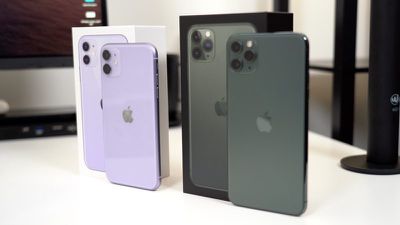
Apple introduced two new iPhone 11 colors this year: purple and green. Our iPhone 11 is the purple color, which is a soft lavender shade that's quite pretty.
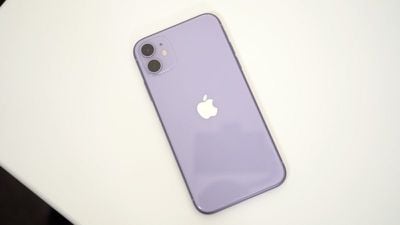
Unboxing the new iPhones is standard procedure and there's nothing that jumps out as new, but the iPhone 11 Pro Max (and the 11 Pro) come with a new 18W USB-C charger and a USB-C to Lightning cable instead of the traditional 5W charger.
With that new 18W cable, the iPhone 11 Pro and Pro Max support fast charging right out of the box. You can charge an iPhone 11 Pro or Pro Max to 50 percent in 30 minutes. The iPhone 11, of course, supports the same fast charging, but it still ships with a 5W charger and a standard USB-A to Lightning cable.
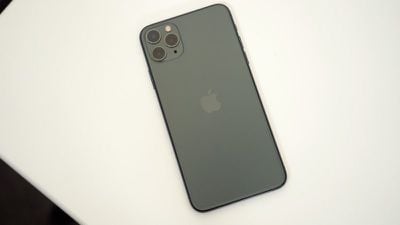
The iPhone 11 Pro Max is heavier than the iPhone XS Max, and just a bit thicker. The extra weight isn't too noticeable, but it's worth noting that the Pro Max is Apple's heaviest iPhone to date. All that weight is attributable to a thicker, heavier battery and a major increase in battery life - the iPhone 11 Pro Max lasts 5 hours longer than the XS Max, and the 11 Pro lasts 4 hours longer than the XS.
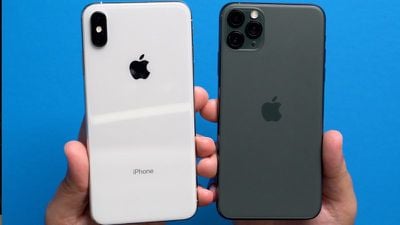
Apple's iPhone 11 also has a longer battery life than the previous-generation iPhone XR, but it's just an hour longer because the XR already had pretty awesome battery life.
The iPhone 11 Pro Max looks similar to last year's iPhone XS Max from the front, but the back stands out because of the new triple-lens camera system and the relocated Apple logo, which is now in the center. There was some chatter that the logo was relocated for bilateral wireless charging, but that's ultimately not a feature that the iPhones launched with.
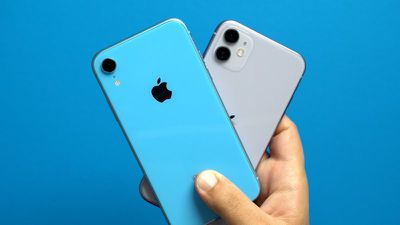
There's also a new dual-lens camera in the iPhone 11, so it too looks different from last year's iPhone XR. The new camera in both iPhones is an ultra wide-angle camera lens that lets you get super wide shots for landscapes, taking photos of architecture, and, well, anything else. It's a neat new camera feature and we're going to delve into it more in a dedicated camera video.
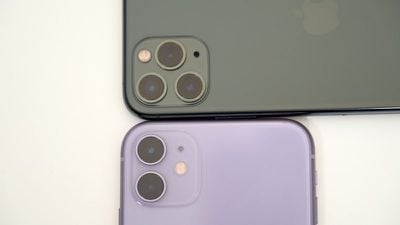
Perhaps the most interesting new camera feature is the new Night mode, which is designed to take crisp, clear shots in low lighting conditions using machine learning and photo aggregation techniques. We'll be testing this out later too, but so far, it looks promising.
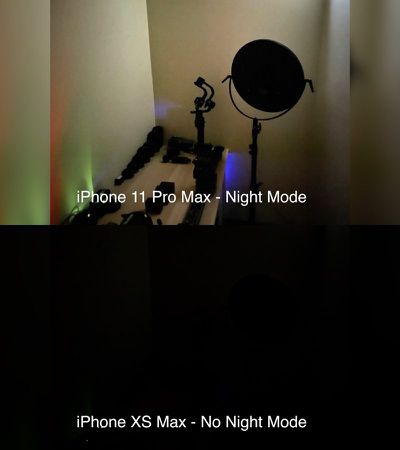
When it comes to the display, the iPhone 11 features the same LCD display as the iPhone XR, but the Pro has a Super Retina XDR display capable of 1200 nits of peak brightness, which is going to be noticeable when it comes to HDR. It's not a big difference, though. The iPhone 11 display isn't as good as the iPhone 11 Pro's display, but it's definitely good enough for most people given the iPhone 11's much lower price point.
3D Touch is gone in all of the new iPhones this year, replaced with Haptic Touch. Haptic Touch does a lot of what 3D Touch does, but it's an adjustment because there's no pressure sensitivity.
Apple says Face ID is 30 percent faster in the new iPhones, and it does seem quicker. Face ID is also supposed to work from more angles, but it still doesn't seem to work from flat on a desk and it still needs to be pointed in the general direction of your face.
All of the new iPhone models use an updated 12-megapixel front-facing camera and there are some notable updates. You can turn the iPhone to landscape mode to capture a wider shot, which is great for group selfies, and there's a new slo-mo camera so you can capture what Apple calls "Slofies." On the iPhone 11, since there are now two cameras, Portrait mode works with all kinds of objects and not just people like it did in the XR.
Apple introduced a new A13 chip in the 2019 iPhones, but last year's iPhones were so quick that it's tough to notice a difference in performance in real-world everyday usage. When it comes to gaming, photography, and AR, though, you may see some faster speeds.
All in all, the iPhone 11, 11 Pro, and 11 Pro Max aren't wildly different from last year's devices in terms of design and internal components, but the camera has received some major updates that really set these new iPhones apart from last year's models. Those who are heavily into iPhone photography might want to update, but the camera-focused update may not appeal to the average user who already has an iPhone XS, XS Max, XR, or even an iPhone X or iPhone 8.
iPhone users who have an older iPhone like a 5, 6, or 7 model will see more satisfying changes, and for these models, the $699 iPhone 11 is the most logical and cost effective update.
Did you get one of Apple's new iPhones? Let us know what you think in the comments. Stay tuned to MacRumors next week because we'll have more video coverage of the new iPhones, including a deep dive into the cameras.
























